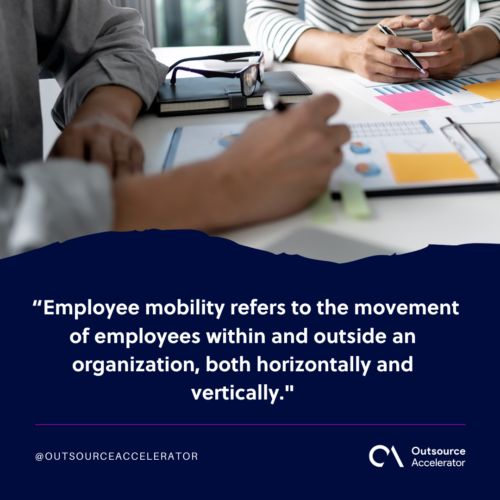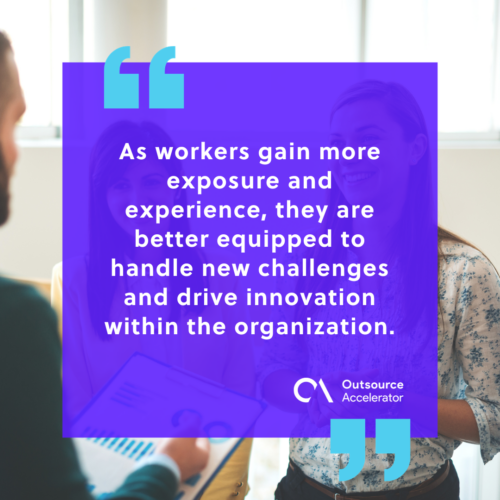Why employee mobility matters

The era of fixed-job roles and linear career paths has come to an end. Employee mobility, characterized by fluidity and adaptability, has become crucial to attracting top talent, fostering innovation, and staying ahead of the curve.
According to a Deloitte survey, 76% of respondents identified talent mobility as a C-suite level topic of importance concerning today’s tight and competitive job market.
So, let’s delve into the different types of employee mobility, its importance, and how to build an effective movement strategy.
What is employee mobility?
Employee mobility refers to the movement of employees within and outside an organization, both horizontally and vertically.
It provides opportunities for workers to expand their skills and knowledge by exposing them to different roles, departments, and geographies.
This movement can be a strategic approach to talent management that fosters growth and innovation.

Types of employee mobility
To dive deeper, let’s explore the various facets of employee mobility:
Career mobility
Career mobility involves employees advancing in their careers, taking on new responsibilities, and climbing the organizational ladder.
It’s the classic upward trajectory that signifies personal and professional growth. This movement allows organizations to retain top talent and groom future leaders.
Internal mobility
Internal mobility is the vertical or horizontal movement of workers within an organization. It’s about giving individuals the chance to explore different roles or departments.
This movement lets staff leverage their skills and bring a fresh perspective to various facets of the business. High internal mobility means a company cares about its employees’ career development.
Talent mobility
Talent mobility or global mobility is the movement of employees between different companies, industries, and even countries.
It allows individuals to acquire diverse experiences, enhance their skills, and develop their careers while allowing organizations to tap into a broader pool of talent and expertise.
Importance of employee mobility
Employee mobility is crucial for both employees and organizations. Here’s why:
Retains top talent
Employee mobility offers an opportunity for workers to develop their skills, expand their knowledge, and explore new career paths.
If done within an organization, it helps increase employee retention and reduces the cost of recruiting and training new staff.
Promotes engagement
Mobility of employees promotes engagement by offering opportunities for continuous learning, development, and exposure to diverse teams.
It gives a sense of growth and fulfillment, making staff feel valued and invested in the company’s success.
Improves performance
Employee mobility leads to increased job satisfaction, productivity, and performance.
As workers gain more exposure and experience, they are better equipped to handle new challenges and drive innovation within the organization.

Increases innovation
By encouraging internal mobility, companies benefit from the cross-pollination of ideas. When members from different departments collaborate, it sparks innovation.
Fresh perspectives can lead to new solutions and approaches, driving the company forward in a competitive landscape.
Agility in a changing landscape
Mobility of employees ensures that your workforce is agile and can swiftly respond to changes.
Whether it’s a shift in market trends or the need for new skill sets, a mobile workforce is better equipped to navigate these changes.
How to build an employment mobility strategy
Building an effective employee mobility strategy takes time and effort but pays off in the long run. Here are some factors to deliberate on:
Transparent communication
Transparent communication is the cornerstone of any successful mobility strategy.
Clearly share the opportunities available, the skills needed, and the potential career paths within the organization. This openness fosters trust and encourages employees to explore mobility options.
Skill development programs
Invest in skill development programs that empower workers to acquire new competencies.
This not only prepares them for different roles but also aligns with the organization’s evolving needs. From workshops to online courses, provide diverse avenues for skill enhancement.
Technology integration
Leverage technology to facilitate internal mobility. Implementing an internal job board or a talent marketplace where team members can explore open positions within the company can streamline the mobility process.
Recognition and rewards
Recognize and reward employees who embrace mobility. This could include acknowledging successful transitions, providing mentorship opportunities, or offering incentives for acquiring new skills.
Positive reinforcement encourages others to follow suit.
Flexibility in work arrangements
Acknowledge that mobility doesn’t always mean a vertical climb. It could also involve flexible work arrangements.
This could allow workers to balance their professional and personal lives. Flexibility is a powerful motivator and can contribute to overall job satisfaction.

Embrace employee mobility within your organization
Employee mobility is a critical component of organizational success in today’s business environment.
By understanding the nuances of mobility, businesses can create an environment where talent flourishes, innovation thrives, and the workforce is ready for whatever the future holds.
It’s not just about moving staff around — it’s empowering individuals to chart their career paths within the organization, creating a win-win for both employees and the company.







 Independent
Independent




